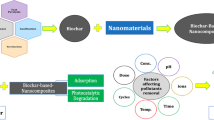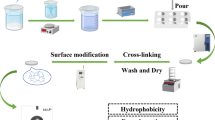Abstract
Alginate-based composites prepared by incorporation of bentonite into alginate or algal hydrogels show promising properties in terms of thermal degradation (mass-loss rate curves under epiradiator irradiation). They can be used as coating agent or as structured materials. Alginates characterized by high guluronic acid content are more efficient for retarding the ignition of tested materials after calcium gelation. Brown seaweed can be directly used for preparing composite blocks with clay; a pretreatment for partial extraction of alginate was introduced in the preparation of the composite material. In order to achieve a better control of drying procedures (with low apparent density, limited shrinking), another kind of composite was successfully elaborated by the incorporation of freeze-dried alginate/bentonite beads into an alginate matrix. Algal biomass (a renewable resource, which requires less processing than when using pure alginate) can be used for the green manufacturing of promising flame-retardant materials (associated to bentonite). Freeze-dried alginate/bentonite beads incorporated in alginate hydrogels show interesting thermal degradation properties allied to low-density characteristics.








Similar content being viewed by others
References
An B, Lee H, Lee S, Lee S-H, Choi J-W (2015) Determining the selectivity of divalent metal cations for the carboxyl group of alginate hydrogel beads during competitive sorption. J Hazard Mater 298:11. doi:10.1016/j.jhazmat.2015.05.005
Hong H-J, Ryu J, Park I-S, Ryu T, Chung K-S, Kim B-G (2016) Investigation of the strontium (Sr(II)) adsorption of an alginate microsphere as a low-cost adsorbent for removal and recovery from seawater. J Environ Manage 165:263. doi:10.1016/j.jenvman.2015.09.040
Xu M, Gagne-Bourque F, Dumont M-J, Jabaji S (2016) Encapsulation of Lactobacillus casei ATCC 393 cells and evaluation of their survival after freeze-drying, storage and under gastrointestinal conditions. J Food Eng 168:52. doi:10.1016/j.jfoodeng.2015.07.021
Hsu F-Y, Wang Z-Y, Chang B-V (2013) Use of microcapsules with electrostatically immobilized bacterial cells or enzyme extract to remove nonylphenol in wastewater sludge. Chemosphere 91:745. doi:10.1016/j.chemosphere.2013.02.019
Nayak AK, Pal D, Santra K (2016) Swelling and drug release behavior of metformin HCl-loaded tamarind seed polysaccharide-alginate beads. Int J Biol Macromol 82:1023. doi:10.1016/j.ijbiomac.2015.10.027
Guibal E, Vincent T, Jouannin C (2009) Immobilization of extractants in biopolymer capsules for the synthesis of new resins: a focus on the encapsulation of tetraalkyl phosphonium ionic liquids. J Mater Chem 19:8515. doi:10.1039/b911318e
Krys P, Testa F, Trochimczuk A et al (2013) Encapsulation of ammonium molybdophosphate and zirconium phosphate in alginate matrix for the sorption of rubidium(I). J Colloid Interface Sci 409:141. doi:10.1016/j.jcis.2013.07.046
Vincent T, Taulemesse J-M, Dauvergne A, Chanut T, Testa F, Guibal E (2014) Thallium(I) sorption using Prussian blue immobilized in alginate capsules. Carbohydr Polym 99:517. doi:10.1016/j.carbpol.2013.08.076
Bertagnolli C, Grishin A, Vincent T, Guibal E (2015) Synthesis and application of a novel sorbent (tannic acid-grafted-polyethyleneimine encapsulated in alginate beads) for heavy metal removal. Sep Sci Technol 50:2897. doi:10.1080/01496395.2015.1085404
Gao W-W, Zhang G-X, Zhang F-X (2015) Enhancement of flame retardancy of cotton fabrics by grafting a novel organic phosphorous-based flame retardant. Cellulose 22:2787. doi:10.1007/s10570-015-0641-z
Pan H, Wang W, Pan Y et al (2015) Construction of layer-by-layer assembled chitosan/titanate nanotubes based nanocoating on cotton fabrics: flame retardant performance and combustion behavior. Cellulose 22:911. doi:10.1007/s10570-014-0536-4
Simoncic B, Hadzic S, Vasiljevic J et al (2014) Tailoring of multifunctional cellulose fibres with “lotus effect” and flame retardant properties. Cellulose 21:595. doi:10.1007/s10570-013-0103-4
Haile M, Fomete S, Lopez ID, Grunlan JC (2016) Aluminum hydroxide multilayer assembly capable of extinguishing flame on polyurethane foam. J Mater Sci 51:375. doi:10.1007/s10853-015-9258-8
Holder KM, Huff ME, Cosio MN, Grunlan JC (2015) Intumescing multilayer thin film deposited on clay-based nanobrick wall to produce self-extinguishing flame retardant polyurethane. J Mater Sci 50:2451. doi:10.1007/s10853-014-8800-4
Hornsby PR, Cusack PA, Cross M, Toth A, Zelei B, Marosi G (2003) Zinc hydroxystannate-coated metal hydroxide fire retardants: fire performance and substrate-coating interactions. J Mater Sci 38:2893. doi:10.1023/a:1024444804764
Liu Y, Zhao J-C, Zhang C-J, Guo Y, Zhu P, Wang D-Y (2016) Effect of manganese and cobalt ions on flame retardancy and thermal degradation of bio-based alginate films. J Mater Sci 51:1052. doi:10.1007/s10853-015-9435-9
Basak S, Samanta KK, Chattopadhyay SK, Narkar R (2015) Thermally stable cellulosic paper made using banana pseudostem sap, a wasted by-product. Cellulose 22:2767. doi:10.1007/s10570-015-0662-7
Zhang H, Chang Z, Qian X, An X (2014) In situ preparation, characterization and performance of magnesium carbonate whiskers/cellulose fibers hybrid paper. Cellulose 21:4633. doi:10.1007/s10570-014-0462-5
Alongi J, Han ZD, Bourbigot S (2015) Intumescence: tradition versus novelty. a comprehensive review. Prog Polym Sci 51:28. doi:10.1016/j.progpolymsci.2015.04.010
Idumah CI, Hassan A (2016) Emerging trends in flame retardancy of biofibers, biopolymers, biocomposites, and bionanocomposites. Rev Chem Eng 32:115. doi:10.1515/revce-2015-0017
Zhang J, Ji Q, Shen X, Xia Y, Tan L, Kong Q (2011) Pyrolysis products and thermal degradation mechanism of intrinsically flame-retardant calcium alginate fibre. Polym Degrad Stab 96:936. doi:10.1016/j.polymdegradstab.2011.01.029
C Zhang, P Zhu, J Zhao, N Zhang (2012) in Shao JH, Fan QG (eds)Eco-Dyeing, Finishing and Green Chemistry
Liu Y, Zhao J, Zhang C, Ji H, Zhu P (2014) The flame retardancy, thermal properties, and degradation mechanism of zinc alginate films. J Macromol Sci Phys 53:1074. doi:10.1080/00222348.2014.891169
Tian G, Ji Q, Xu D, Tan L, Quan F, Xia Y (2013) The effect of zinc ion content on flame retardance and thermal degradation of alginate fibers. Fibers Polym 14:767. doi:10.1007/s12221-013-0767-2
Zhang J, Ji Q, Wang F, Tan L, Xia Y (2012) Effects of divalent metal ions on the flame retardancy and pyrolysis products of alginate fibres. Polym Degrad Stab 97:1034. doi:10.1016/j.polymdegradstab.2012.03.004
Chen H-B, Wang Y-Z, Sánchez-Soto M, Schiraldi DA (2012) Low flammability, foam-like materials based on ammonium alginate and sodium montmorillonite clay. Polymer 53:5825. doi:10.1016/j.polymer.2012.10.029
Shang K, Liao W, Wang J, Wang Y-T, Wang Y-Z, Schiraldi DA (2016) Nonflammable alginate nanocomposite aerogels prepared by a simple freeze-drying and post-cross-linking method. ACS Appl Mater Interfaces 8:643. doi:10.1021/acsami.5b09768
Wang W, Pan H, Shi Y et al (2015) Sandwichlike coating consisting of alternating montmorillonite and beta-FeOOH for reducing the fire hazard of fexible polyurethane foam. ACS Sustainable Chem Eng 3:3214. doi:10.1021/acssuschemeng.5b00805
Kusuktham B, Prasertgul J, Srinun P (2014) Morphology and property of calcium silicate encapsulated with alginate beads. Silicon 6:191. doi:10.1007/s12633-013-9173-z
Pan H, Wang W, Pan Y, Song L, Hu Y, Liew KM (2015) Formation of layer-by-layer assembled titanate nanotubes filled coating on flexible polyurethane foam with improved flame retardant and smoke suppression properties. ACS Appl Mater Interfaces 7:101. doi:10.1021/am507045g
Lyon RE, Walters RN (2004) Pyrolysis combustion flow calorimetry. J Anal Appl Pyrolysis 71:27. doi:10.1016/s0165-2370(03)00096-2
Huggett C (1980) Estimation of rate of heat release by means of oxygen-consumption measurements. Fire Mater 4:61. doi:10.1002/fam.810040202
Quong D, Neufeld RJ, Skjak-Braek G, Poncelet D (1998) External versus internal source of calcium during the gelation of alginate beads for DNA encapsulation. Biotechnol Bioeng 57:438
Iijima M, Hatakeyama T, Nakamura K, Hatakeyama H (2002) Thermomechanical analysis of calcium alginate hydrogels in water. J Therm Anal Calorim 70:807. doi:10.1023/a:1022252102869
Simpson NE, Stabler CL, Simpson CP, Sambanis A, Constantinidis L (2004) The role of the CaCl2-guluronic acid interaction on alginate encapsulated beta TC3 cells. Biomaterials 25:2603. doi:10.1016/j.biomaterials.2003.09.046
Funami T, Fang Y, Noda S et al (2009) Rheological properties of sodium alginate in an aqueous system during gelation in relation to supermolecular structures and Ca(2+) binding. Food Hydrocolloids 23:1746. doi:10.1016/j.foodhyd.2009.02.014
Wandrey C, Espinosa D, Rehor A, Hunkeler D (2003) Influence of alginate characteristics on the properties of multi-component microcapsules. J Microencapsulation 20:597. doi:10.1080/0265204031000148022
Kuo CK, Ma PX (2001) Ionically crosslinked alginate hydrogels as scaffolds for tissue engineering: part 1: Structure, gelation rate and mechanical properties. Biomaterials 22:511. doi:10.1016/S0142-9612(00)00201-5
Dorez G, Ferry L, Sonnier R, Taguet A, Lopez-Cuesta JM (2014) Effect of cellulose, hemicellulose and lignin contents on pyrolysis and combustion of natural fibers. J Anal Appl Pyrolysis 107:323. doi:10.1016/j.jaap.2014.03.017
Manns D, Deutschle AL, Saake B, Meyer AS (2014) Methodology for quantitative determination of the carbohydrate composition of brown seaweeds (Laminariaceae). RSC Adv 4:25736. doi:10.1039/c4ra03537b
Schiener P, Black KD, Stanley MS, Green DH (2015) The seasonal variation in the chemical composition of the kelp species Laminaria digitata, Laminaria hyperborea, Saccharina latissima and Alaria esculenta. J Appl Phycol 27:363. doi:10.1007/s10811-014-0327-1
Author information
Authors and Affiliations
Corresponding author
Ethics declarations
Conflict of interest
The authors declare that they have no conflict of interest.
Electronic supplementary material
Below is the link to the electronic supplementary material.
Rights and permissions
About this article
Cite this article
Gady, O., Poirson, M., Vincent, T. et al. Elaboration of light composite materials based on alginate and algal biomass for flame retardancy: preliminary tests. J Mater Sci 51, 10035–10047 (2016). https://doi.org/10.1007/s10853-016-0230-z
Received:
Accepted:
Published:
Issue Date:
DOI: https://doi.org/10.1007/s10853-016-0230-z




